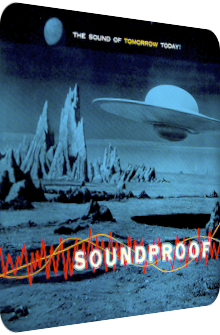
Ferrante & Teicher
Soundproof
1955
“If you do not have the finest high quality audio equipment, don’t bother to play this record.” This introductory sentence off the liner notes of Arthur "Art" Ferrante’s (1921–2009) and Louis Teicher’s (1924–2008) Space-Age p(i)anorama Soundproof is potentially audacious and insulting, but that should not be much of a problem anymore, at least not to the Space-Age connoisseur. Recorded in 1955 and officially released right at the beginning of 1956 on Westminster Records, Soundproof is a 12-track artifact which breathes, lives and, er, expectorates due to the eclectic and partially labyrinthine yet always exquisite interplay between two of the very best pianists of their time. Having played together since the age of six, Ferrante & Teicher surely know how to let proper dynamics unfold.
While being rooted in the stereo craze phenomenon and thus severely advertising the technical prowess that made the record become reality, Soundproof is much keener on its material and instrumental pool. Uniting exotic, earthen and cosmic vignettes on one LP with the help of two pianos, one celesta, a glockenspiel and many filters such as frequency cutoff appliances, inverters and other trickeries that interpolate the alien notions of the presented gems, Ferrante & Teicher create a unique soundscape that is potentially off-putting due to its purposeful frostiness and incisive tone sequences, but then surprises several times with the expected periods of grace and solemnity that live up to the respective composer’s original vision. On top of these renditions, four unique tracks are featured. Soundproof exists in multitudinous versions, the mono incarnations being called Soundblast, others being named Soundproof as well despite featuring different tracks altogether. Skip to the final paragraph to see this turbulence resolved; this review, meanwhile, is based on the version that begins with an important question.
Even in moonlit Space-Age times, one essential question remains as pressing as ever: What Is This Thing Called Love? Originally envisioned by Cole Porter, Arthur Ferrante and Louis Teicher take the original hooks and segues of Porter’s gem and throw it into the whitespace. Comprising a pizzicato string-evoking piano base frame that resembles sanguine strings found in horror flicks and plinking echo-fueled piano shards, it is only the lead melody that showcases the familiar frequency range of the duo’s signature instrument. Everything else feels either ashen or as blazingly turquoise-bluish as the front artwork. An added celesta is probably the most striking ingredient. Its pristine iridescence boosts the capaciousness whereas the calcined afterglow is laid over the rustic rhythm piano. An enormously eerie take of this classic whose eldritch proportions only grow when one distills the scattered traces of euphony from it.
Rafael Hernández’s sun-soaked El Cumbanchero finds its golden aura perfectly intact, although the duo of pianists revs up the ebullience to the maximum. Hammering pianos, strangely wooden dissonances, histrionic Latinisms and quirky Gothic harmonies send a shiver or two down one’s spine, a situation which is then rectified by genuine waves of warmth here and there. Ferrante & Teicher’s take remains a scuttling critter though.
The traditional Folk song, music box anthem and nursery rhyme Greensleeves is almost universally known all over the Occidental parts of the world, and it turns out to be a curiously drifting and highly enigmatic piece in the given surroundings, augmenting its galactic theme by the means of a genteel placidity rather than convoluted tercet entanglements. A glockenspiel and actually euphonious piano accentuations are the basic ingredients, the conception of an empty space feels stronger than before, as the relative quiescence and downbeat structure of Greensleeves allow the sustain phases of the piano and glockenspiel to die away in grace. A space ambience par excellence, highly accessible, still mystical.
The following three pieces, however, are real treats, for they are unique cuts conceived by the duo itself, at least partially so. Mississippi Boogie is a bucolic stamping mill loaded with bone-crushing piano tones and a rhythm which schleps itself forward only very reluctantly. The second phase then unleashes a blithesome mayhem of another essential Folk melody played on a glockenspiel in adjacency to hefty staccato splinters of the joyful kind. Mermaid Waltz then takes the listener to subaquatic realms with its genuinely soothing ambience. The pianos are strangely altered, sound thin and washy as if they were perceived under a dive bell or cheese cover, but the effect works wonders and is not gimmicky at all. The celesta experiences the same warbled effect. The intertwinement of sound, sustain and space is magnificent and makes Mermaid Waltz my top pick of side A. Enchanting, aquatic, incredibly blue. And now, from the ocean to the surface of Mars in seconds: Man From Mars is the lamenting closing track of side A, with Ferrante’s deep rhythm piano stabs clashing with Teicher’s cicada-esque glitters and perfectly pernicious piano prongs. The immediacy and tension of this arcane piece remind the listener of the overarching theme: Space-Age suprème.
Side B kicks off with two soon-to-be Exotica classics which, at the time of recording the album in 1955, had their best times yet to come. Ary Barroso’s Baía is a superb Exotica cut for astronauts. The eminently Brazilian dreaminess is intransigently injected into the arrangement and draped in such warm hues that its thermal heat covers every source of frostiness, be it the electric tambourines, the clicking claves or the looming backdrop of the soundless pith. Barroso’s opus shows that a great melody is literally immortal, even in immoral surroundings. Ernesto Lecuona’s The Breeze And I keeps the exotic vibe going thanks to its wave-like rhythm pianos, the sweeping glissando as well as the pointillistic lead melody. Even the darker accentuations only serve the supremacy of the main theme, with the gimmick of a champagne cork-insinuating popping sound being the only Space-Age or bachelor pad reminder.
While George and Ira Gershwin’s Someone To Watch Over Me is strangely hypnotic and designedly pallid due to the rotor-esque backing piano coils and the wondrously twinkling celesta sparks which altogether nurture the nocturnal aura, Ferrante & Teicher’s own African Echoes is a corker that appears on many of their albums, succeeding each time thanks to its mercilessly fulminant capsules of adamantly dissonant chord gales which nonetheless emanate a gleeful luminosity. The take on Soundproof would not be particularly spacey, were it not for the thundering yet muffled dark piano blebs in the distance which seem to be surrounded by dark matter. And the darkness shall remain, both in the title and the soundscape: Dark Eyes is a traditional Russian Folk song whose balalaika placenta is replaced by the sizzling fragility of a thinned piano. Everything feels dusky and vacuous, the first two minutes are enormously reduced and cautious, with the final minute drawing from a warped and brutish ignis fatuus and archetypically Russian twilight clichés. Lorenz Hart’s and Richard Rodger’s Lover then closes the circle and leads to Cole Porter’s question of the album’s opener. This love theme is taken into space, has its lachrymose aurora intact, is still chock-full of rose-tinted tercets, but sees its tempo unflinchingly wound up by Ferrante & Teicher. The ensuing rhythm thicket is excitingly bubbly and adds the necessary galactic counterpoint to the earthen bliss.
Soundproof is by no means an opus eximium of the Space-Age phantasmagoria, i.e. the very mélange of releases that caused a decade-long craze which started before the Exotica movement and outlasted it by several years, but still remains a great entry in the discography even without a single glimpse of a theremin or vestiges of multifaceted strings. This is all Ferrante & Teicher, with many a fan hailing this as one of the duo’s stardust-illumined hours. With just two pianos, a celesta and a glockenspiel as well as many creative filters, Soundproof gyrates around the milky way, submerges into aquatic underwater realms and smuggles out the gold nuggets of the US book of Jazz standards. Even two opalescent Exotica cuts made it here. The album is incessantly perturbed by ubiquitous discords and a wealth of dissonant chords that are performed over the top, but the vibrance, energy and aura unfold greatly. Despite the gadgetries and technological advancements mentioned in the liner notes, Soundproof is more about the echopraxia of melodies and less about the filters.
Considering the wealth of material and the skillful interdependence of the artists, it is only understandable that some people perceive the duo’s later works as all too smarmy and streamlined, among them the – to me – grandiloquently orchestra-underpinned Exotica rain forest called Pianos In Paradise (1962). Soundproof is much more blotchy, with many polka dots, jots and quirky vesicles as well as designedly inharmonious triplets creating a maelstrom in true Space-Age fashion. Don’t let the messy release dates and many versions dampen your interest! Soundproof is reissued in 2007 by the Cherry Red label which provides the two principal versions of Soundproof on one CD, so there is no need to ponder which version to get. It has also been reissued in 2012 by the Crates Digger Music Group which comprises the version of this review. Both are also available in digital music stores, waiting for you to take the alienating yet exciting trip to an orbit of your choice.
Exotica Review 264: Ferrante & Teicher – Soundproof (1955). Originally published on Sep. 28, 2013 at AmbientExotica.com.
